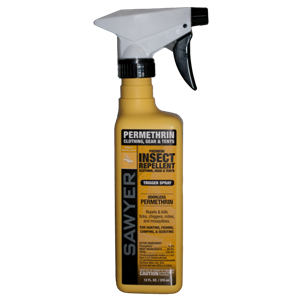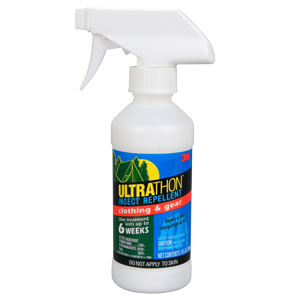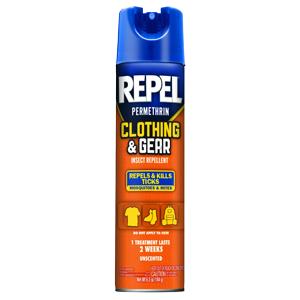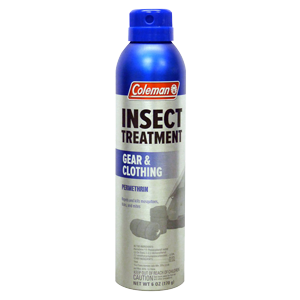Permethrin is an insecticide that has applications as an insect repellent in low concentrations (0.5%). Permethrin repellents are sprayed directly on clothing and gear. It remains effective on fabrics for up to two weeks, even through laundering. Wearing permethrin-treated clothing will prevent up to 97% of mosquito bites.
History Efficacy Mode of Action Toxicity
 |
 |
 |
 |
|
| Product Name | Sawyer Premium | 3M Ultrathon | Repel Clothing & Gear | Coleman Gear & Clothing |
| Price | $15 | $10 | $10 | $8 |
| Size | 24 ounces | 8 ounces | 6.5 ounces | 6 ounces |
| Capacity | 4 outfits | 1.5 outfits | 1 outfits | 1 outfits |
| Application | Pump Spray | Pump Spray | Aerosol | Aerosol |
| Use On | Clothes | Clothes | Clothes | Clothes |
| Active Ingredients | Permethrin | Permethrin | Permethrin | Permethrin |
| A.I. Concentration | 0.5% | 0.5% | 0.5% | 0.5% |
| Duration | 2 weeks | 2 weeks | 2 weeks | 2 weeks |
| Product Label | ||||
| MSDS | ||||
| FleaScore | ||||
| Reviews |
- Prices are approximations based off of Amazon.com prices at the time of publishing.
- FleaScores are based off of product details (price, size, active ingredients, etc), as well as reviews aggregated from 3rd party sources.
What is Permethrin?
Permethrin in an insecticide, but in low concentrations is used as an insect repellent. Permethrin is safe to use on clothing and gear, but should not be applied topically to skin, as it is somewhat toxic. Used alone on clothing, it is nearly as effective at preventing bug bites as DEET.
Permethrin
Chemical Overview
| Chemical type | Pesticide – insect and acarid repellent |
| Chemical family | Pyrethroids |
| Common name | Permethrin |
| INCI name | Permethrin |
| IUPAC name | 3-Phenoxybenzyl (1RS)-cis,trans-3-(2,2-dichlorovinyl)-2,2 dimethylcyclopropanecarboxylate |
| CA name | Cyclopropanecarboxylic acid, 3-(2,2-dichloroethenyl)-2,2-dimethyl-, (3-phenoxyphenyl)methyl ester |
| CAS No. | 52645-53-1 |
| Molecular formula | C21H20CI2O3 |
| Molecular mass | 391.3 g/mol |
| Physical state | Crystal or liquid |
| Odor | Odorless |
| Color | Colorless (crystal) or slight yellow/brown (liquid) |
| Molecular Structure |  |
History
Permethrin was first synthesized in 1973. It was modeled after pyrethrum, a powerful, rapid acting insecticide which is derived from dried Chrysanthemum flowers.
Permethrin is part of the third-generation of synthetic pyrethriod insecticides. It was first synthesized in 1973. Permethrin was modeled after pyrethrum, a powerful, rapid acting insecticide which is derived from the dried Chrysanthemum flowers.
Permethrin is four times more effective as an insecticide than natural pyrethrins. It also has superior chemical stability in heat and sunlight, so it degrades slower.
In 1979, permethrin was registered with the Environmental Protection Agency (EPA) for use on cotton crops. The EPA conditionally registered the chemical in order to reduce the use of other, more carcinogenic, pesticides. Permethrin was then re-registered with the EPA in 2006.
From 1982 to 1989, permethrin was approved as an insecticide for use on over 55 crops, including broccli, celery, lettuce, potatoes alfalfa, and pears. It was also used in the production of meat, eggs and milk.
In 1990, permethrin became the first and only pesticide to be registered with the EPA as an insect repellent for pre-treating fabrics.
In 1990, permethrin became the first and only pesticide to be registered with the EPA as an insect repellent for pre-treating fabrics.
In 1990, clothing factory-treated with permethrin was also registered with the EPA. In 2009, the EPA evaluated the risk of factory-treated clothing and determined it was unlikely to pose any risk to people wearing the clothes.
Today, permethrin is used as both a pesticide and an insect repellent. As an insecticide it is used manage pests on crops, kill parasites on livestock, and to control insects on industrial sites. As an insect repellent it is used on timber to repel pests, personal clothing to prevent insect bites, and can be found in flea prevention products for pets.
Permethrin can be found in concentrates, powers, dusts, granules and ready-to-use formulas.
Permethrin is on the World Health Organization’s List of Essential Medicines, mainly for the treatment of scabies.
Efficacy (as a repellent)
Permethrin is a broad-sprectrum repellent, preventing bites from a wide variety of arthropods such as a fleas, mosquitoes, biting flies and ticks.
After treating clothing with permethrin, the garments will remain effective at repelling insects for up to two weeks and through up to 20 launderings.
Permethrin is a broad-spectrum insecticide and repellent, as such it affects insects indiscriminately. It will repel a wide variety of biting pests, such as fleas, mosquitoes, ticks, biting flies and chiggers.
Permethrin insect repellents come in a ready-to-use, 0.5% concentration spray or aerosol. Application involves spraying each side of a desired piece of clothing with the repellent until the fabric is moistened. The clothing is wearable after it has dried for two to four hours. Permethrin is non-staining and does not have any damaging (plasticizing) effect on materials like DEET does.
The permethrin will bind into cloth fibers, making it resistant to getting wet, washing and hard wear. After treating clothing with permethrin, the garments will remain effective at repelling insects for up to two weeks and through up to 20 launderings. Permethrin is resistant to degradation from heat and sunlight.
The US and British militaries are now using a permethrin polymer coating technique. All new military uniforms are factory-impregnated with a permethrin polymer to help prevent the spread of malaria by mosquitoes. Using this technique, studies have shown the repellent effect is effective well after the clothes are washed 50 times. The uniforms are believed to repel insects for the life of the clothes. In the United States, pre-treated permethrin clothing for consumers can be found labeled “Insect Shield” (formly BuzzOff).
Clothing treated with a 0.5% permethrin repellent will provide protection from up to 97.7% of mosquito bites. Repellency increases to 99.9% when coupled with topically applied DEET.
A study done by the U.S. Army and U.S. Air Force concluded that clothing treated with 0.5% permethrin offered 97.7% protection from mosquitoes. Protection went up to 99.9% when coupled with DEET applied to exposed skin.
A similar field study was done in Alaska with permethrin and DEET agaisnt the mosquito Culiseta impatiens. Untreated, volunteers were getting 1188 bites an hour. Using permethrin on clothes resulted in 93% protection from mosquito bites, 78 bites an hour. When the treated clothing was coupled with topically applied DEET to exposed skin, bite protection went up to 99.9%, 1 bite per hour.
Mode of Action (as a repellent)
Permethrin is a contact pesticide. Insects that come in contact with permethrin-treated clothing are paralyzed or killed.
Although permethrin is labeled as an insect repellent in low concentrations, it is still actually a contact pesticide. Insects that contact permethrin-treated fabrics are paralyzed or killed, also known as “knockdown”.
Permethrin targets an insect’s nervous system, causing rapid and repetitive muscle spasms. Resulting in a “knockdown” effect.
Permethrin is a type I pyrethroid, as such it primarily targets an insect’s nervous system, causing muscle spasms. Permethrin (and other pyrethroids) is a toxin to nerve membrane sodium channels. The permethrin compound binds to sodium channel proteins, which slows down the rate of inactivation of the sodium current induced by membrane depolarization. As a result, the sodium channel is opened for a prolonged duration.
In low concentrations (such as in 0.5% repellents), permethrin affects insects by triggering rapid, repetitive neuron firings. In high concentrations, the insect’s nerve membrane is depolarized completely and excitation is blocked. The end result in both cases is paralysis and death.
Toxicity
Permethrin
Toxicity Data
| Acute Dermal Exposure | III | I = Highly Toxic | |
| Acute Oral Exposure | III | II = Moderately Toxic | |
| Acute Inhalation Exposure | IV | III = Slightly Toxic | |
| Primary Skin Irritation | IV | IV = Practically Non-Toxic | EPA Repellent Safety |
| Primary Eye Irritation | III | CDC Repellent Safety | |
| Dermal Sensitizer | No | AAP Repellent Safety | |
| Carcinogen | Yes | ||
| Fish | I | ||
| Aquatic Invertebrates | – | ||
| Birds | IV |
Permethrin has a low toxicity to humans and a high affinity for cloth. As a result, the skin absorption rate is extremely low. People wearing permethrin-treated clothing do not come anywhere near toxic levels of exposure.
Permethrin has a low toxicity to humans and a high affinity for cloth. As a result, the skin absorption rate is extremely low. People wearing permethrin-treated clothing do not come anywhere near toxic levels of exposure.
Permethrin has a low mammalian toxicity (with an exception to cats). Permethrin is classified slightly toxic for acute toxicity related to oral, dermal and ocular routes of exposure.
Permethrin does not absorb well into skin. It has a a dermal absorption factor of 5.7% according to evaluations done by the EPA during registration. This is believed to be a conservative estimate. Some studies conclude skin absorption rates are less than 2% of the applied dose.
If permethrin is absorbed by the body, it is rapidly broken down into metabolites by the liver. The metabolites are then quickly excreted through urine. Permethrin does not persist significantly in body tissues. It is almost completely eliminated from the body within a few days.
The EPA has stated that there is reasonable certainty that permethrin causes no harm to infants and children.
The EPA concluded that there is no evidence that permethrin has an increased susceptibility for infants and children. The agency states that there is reasonable certainty of no harm to infants and children.
According to the EPA, compared to other pesticides, permethrin is much less likely to result in serious or persistent medical conditions.
Data from poison control hotlines shows that the majority of permethrin poisonings came from misuse and inadvertent exposures. Most of these were from dermal exposure and resulted in minor health issues such as redness, rashes, irritation and itching. Other reported adverse health effects were irritation and burning of the eyes, headaches, nausea, dizziness, vomiting and difficulty breathing. Only one death has ever been reported in relation to permethrin, which was caused by pneumonitis. This fatality was most likely not caused by permethrin, but rather by a xylene solvent.
In 2009, the EPA concluded that permethrin is likely to be carcinogenic to humans through the oral route of exposure.
Permethrin is very highly toxic to cats and can lead to fatality, even from secondary exposure (e.g. treated dogs).
In 1991, the International Agency for Research on Cancer (IARC) determined that permethrin was not classifiable as to its carcinogenicity to humans due to lack of evidence. In 2009, the EPA concluded that permethrin is likely to be carcinogenic to humans through the oral route of exposure.
Permethrin is often used as a topical flea treatment for dogs. While believed to be safe for dogs, it is very highly toxic to cats and can lead to death. Fatality in cats can be caused through direct exposure or secondary exposure from contact with treated dogs.
Peremthrin is very highly toxic to all insects, including beneficial insects such as honey bees.
Permethrin is very highly toxic to fish, but practically non-toxic to birds. The EPA has classified peremthrin as a “restricted use” substance because of its high toxicity to fish and other aquatic life.


